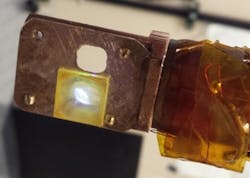Platinum-rich polymer with color-tunable emission may enable truly white OLED
Salt Lake City, UT--By inserting platinum atoms into an organic semiconductor, University of Utah physicists can tune the polymer to emit light of different colors—a step toward truly white organic LEDs (OLEDs) for lighting.
Existing white-emitting OLEDs use other techniques for white output, such as a blue OLED combined with a yellow phosphor by Novaled, or other phosphorescent approaches such as those by Universal Display Corporation and Konica Minolta.
Platinum inserted in polymer chain
In the new study, University of Utah physicist Z. Valy Vardeny and colleagues report how they inserted platinum metal atoms at different intervals along a chainlike organic polymer, and thus were able to adjust or tune the colors emitted. This is a step toward a truly white OLED generated by multiple colors from a single polymer. The results were published online Friday, Sept. 13, 2013 in the journal Scientific Reports.
“This polymer emits light in the blue and red spectral range, and can be tuned to cover the whole visible spectrum,” says Vardeny. “As such, it can serve as the active [or working] layer in white OLEDs that are predicted to replace regular light bulbs.”
The new platinum-doped polymers can convert more energy to light than other OLEDs now under development, Vardeny says. This is because the addition of platinum to the polymer makes accessible more energy stored within the polymer molecules: in addition to the singlet state already accessible by conventional OLEDs, the normally inaccessible triplet state is usable in the new technique.
For the study, the researchers used two versions of the same polymer. One version, Pt-1, had a platinum atom in every unit or link in the chain-like semiconducting polymer. Pt-1 emitted violet and yellow light. The other version, Pt-3, had a platinum atom every third unit, and emitted blue and orange light. By varying the amount of platinum in the polymer, the physicists could create and adjust emissions of fluorescent and phosphorescent light, and adjust the relative intensity of one color over another.
Not yet OLEDs
However, the polymers in the study aren’t OLEDs yet because they are pumped optically, rather than electrically. Vardeny predicts a span of about one year until the design of a “platinum-rich pi-conjugated polymer” that is tuned to emit white light when stimulated by light, and about two years until development of true white OLEDs.
The University of Utah conducted the research with the Los Alamos National Laboratory (Livermore, CA). Additional funding came from the National Science Foundation’s Materials Research Science and Engineering Center program at the University of Utah, the National Natural Science Foundation of China, and China’s Fundamental Research Funds for the Central Universities.

John Wallace | Senior Technical Editor (1998-2022)
John Wallace was with Laser Focus World for nearly 25 years, retiring in late June 2022. He obtained a bachelor's degree in mechanical engineering and physics at Rutgers University and a master's in optical engineering at the University of Rochester. Before becoming an editor, John worked as an engineer at RCA, Exxon, Eastman Kodak, and GCA Corporation.
